

WARNING: I've seen computers that have trouble when USB 3 devices are plugged in before the computer boots. One friend's computer wouldn't boot at all ... took forever to isolate the problem to the USB 3 card reader. One of my computers did weird things with things plugged into USB 3 ports: sometimes it didn't recognize the second monitor, other time it didn't find the second DVD drive.
Jump to the 12/23/2013 updates, or the 12/27/2013 discussion of Flash Drives
The first USB ports started to appear in 1996, but were not widely used until machines with USB 1.1 ports started to appear late in 1998. USB 1 speeds were 1.5 Mbits/sec (low-bandwidth) and 12 Mbits/sec (full-bandwidth).
USB 2 was "released" in 2000 and became widely used 2 in about 2003. It had a maximum signaling rate of 480 Mbits/sec (effective throughput up to 35 MB/sec or 280 Mbits/sec).
USB 3 was "released" in 2008, and we started to see the first motherboards with USB 3 ports in 2010. USB 3 devices started to appear in 2011 and now by late 2012 they are common. The USB 3 standard claims a theoretical "maximum" transmission speed of up to 5 Gbits/sec (625 MB/sec) but it will be quite a while before hardware advances will allow us to see more than one quarter of that speed.
What's great is that USB 3 is backwards compatible with USB 2. You can plug USB 3 devices into USB 2 ports, or USB 2 devices into USB 3 ports, and they work. Just at USB 2 speeds.
Based on the maximum speeds in the specification, one might think USB 3 might be 20 times faster than USB 2, but that's not the case. What is it really?
Skip all the details and geek speak, jump right to the bottom line.
I decided to try some tests. I took a brand new USB 3 external hard drive (2.5" drive powered by the USB port) and timed copying a couple of folders using both USB 2 and USB 3. I purposely used two folders with very different kinds of files and structures.
Folder 1 contains thousands of small files in hundreds of sub-folders. This structure is more typical of text documents, none are very big but I have LOTS of them. The test folder actually contained 2,265 folders and 48,185 files and the total size was 8.43 GB (8,642 MB).
Folder 2 contains hundreds of large file and no sub-folders. This might be typical of picture files taken with a high-resolution camera. The test folder actually had 1,843 files and the total size was 24.6 GB (8,642 MB). About 1500 RAW files from dSLR cameras; about 250 JPGs, which are quite a bit smaller than the RAW files; 10+ PSD files, larger than RAW files; and 80+ XMP files which are very small, more the size of documents.
First I copied Folder 1 to the external drive using a USB 2 port on the front of the computer. Folder 1 started on an 7,200 rpm internal drive connected to a 6 Gb/s SATA port. The copy start off and for some reason the first files it's copying are quite large, the copy quickly reaches a speed of 28 MB/s. This is about the best you'll do on a USB 2 port, which theory says has a 35 MB/s maximum speed (that you'll never reach):
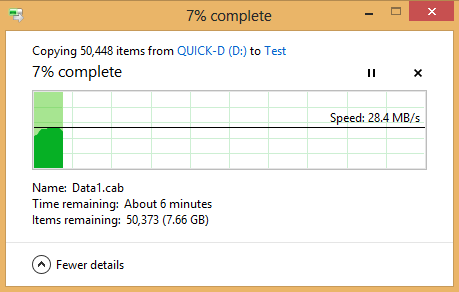
However, after a while the speed starts to jump around:
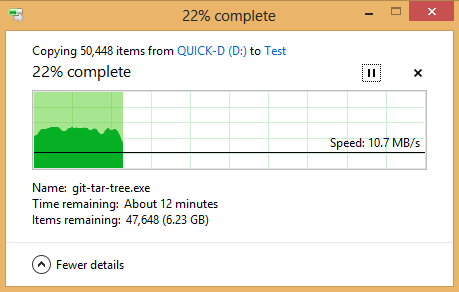

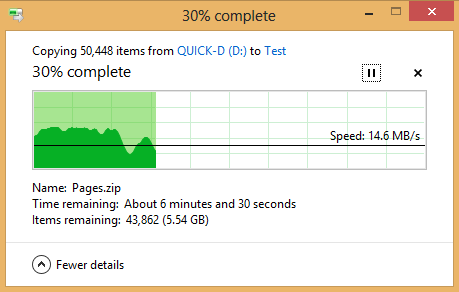
I think the drop in the transfer rate is happens when creating sub-folders on the external drive.
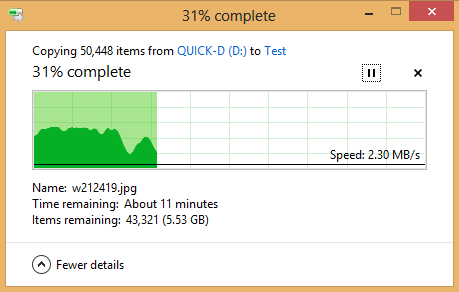
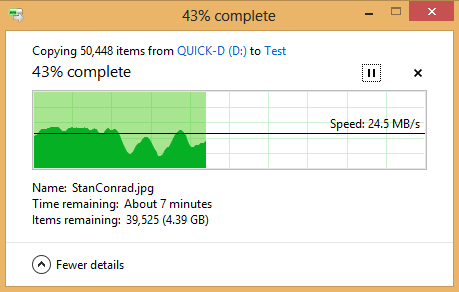
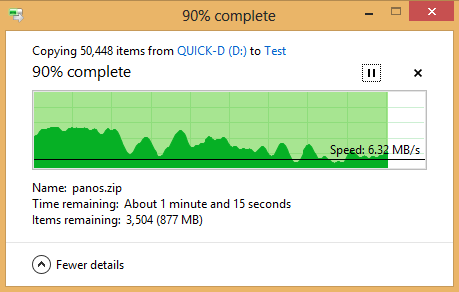

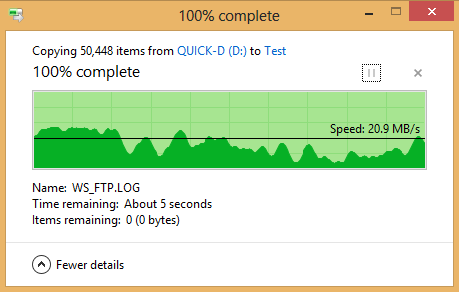
The total time for the copy was about 11 minutes and 15 seconds, making the average transfer rate 12.8 MB/s according to my calculations.
Next I copied Folder 1 to the external drive again, but this time the drive was plugged into a USB 3 port. Again, because of the large files being copied first, it got off to a VERY fast start:
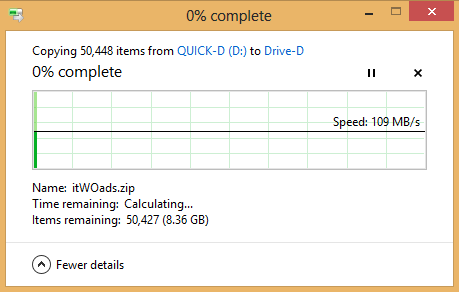
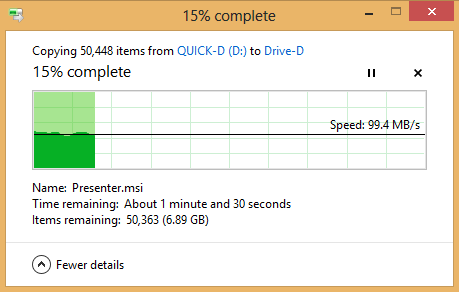
That initial transfer rate is between 3.5 and 4 times the transfer rate of the USB 2 port. But then we starting seeing the same kinds of fluctuations in the transfer rate we saw before, but percentage wise they were even more because the limiting factor is the time it takes the hard drive to update its file system as each sub-folder is created:
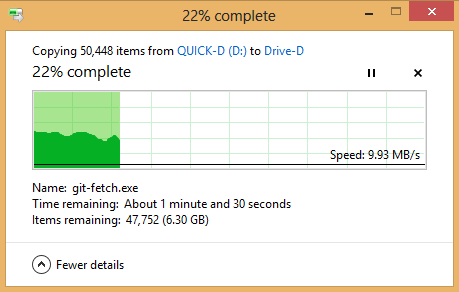
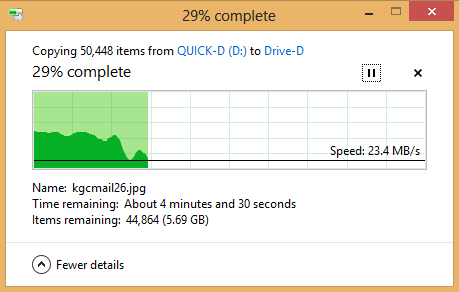
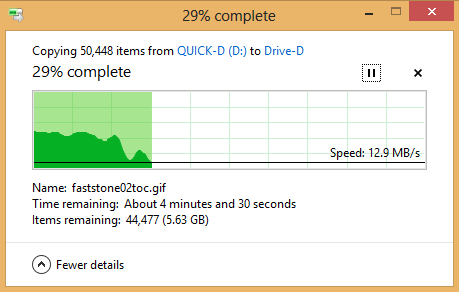

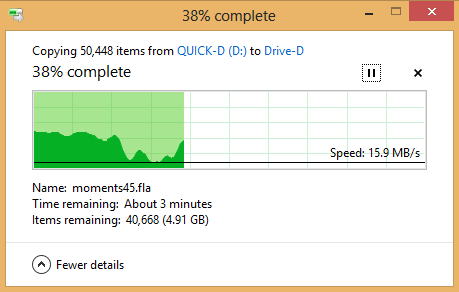
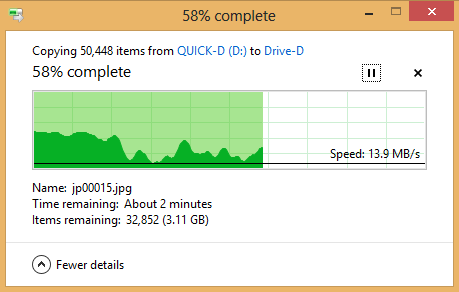
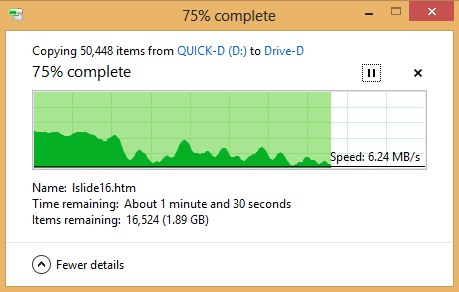
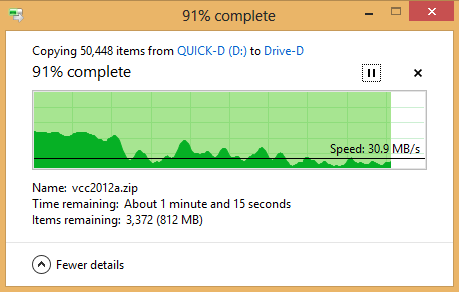
The total time for the copy was about 4 minutes and 55 seconds, making the average transfer rate 19.6 MB/s according to my calculations. That's about 53% faster than the USB 2 port.
OK, now let's look at what happens copying a single folder with mostly large files. First attached to a USB 2 port:
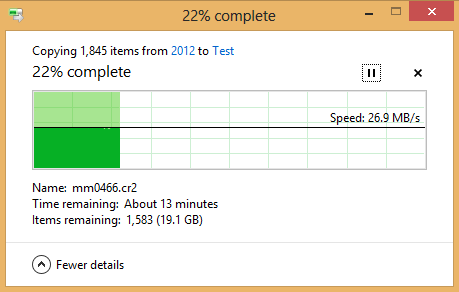
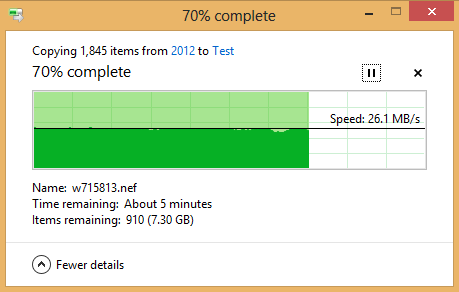
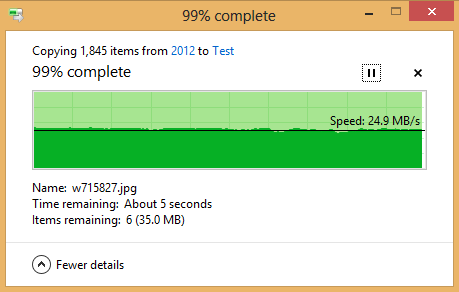
As you can see, the transfer rate was pretty constant. Total time 15 minutes and 55 seconds, making the average transfer rate 24.6 MB/s using just USB 2. That's close to the rated speed of the port and the average is even faster than Folder 1 transferred via USB 3.
Now let's look at copying Folder 2 using USB 3:
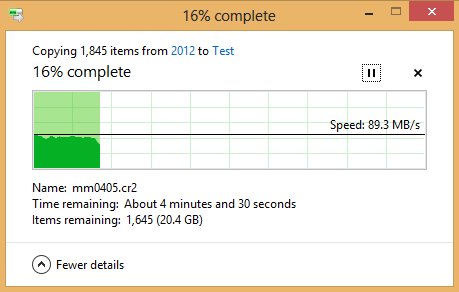
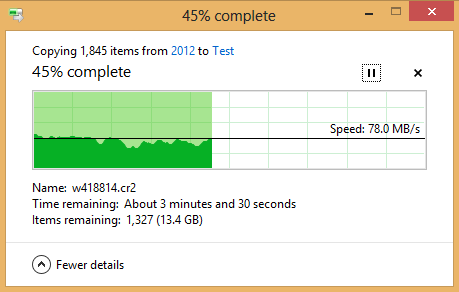
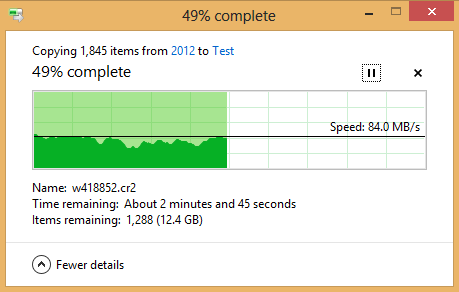
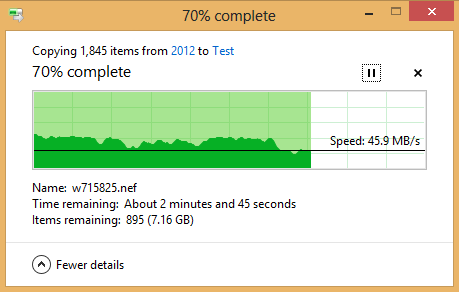
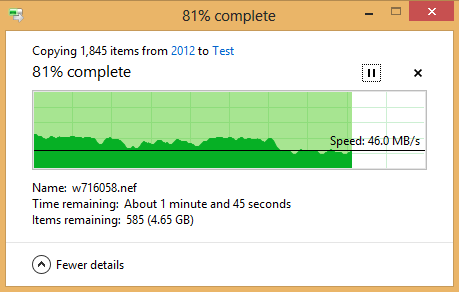
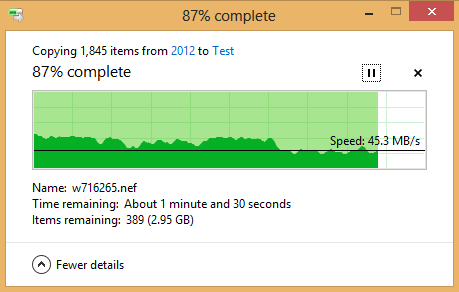
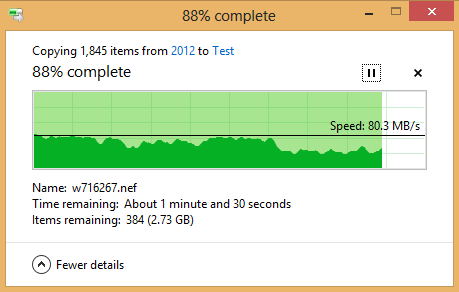
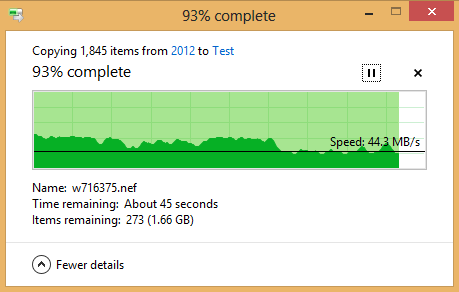

I have no idea why the speed isn't more constant. I don't believe anything else was happening, but it might be worth running the test again. In any case the total time was about 7 minutes, so the average transfer rate was 60 MB/s, or about 2.44 times than using the USB 2 port.
In thinking about it, I decided the higher than expected fluctuation in speed might be caused by fragmentation on the source disk, and the fact that the files might be somewhat scattered around the disk; I knew the external drive had no fragmentation. When doing the read tests (below) I ended up with copies of the same folders all together in one place on an internal drive and with no fragmentation. I tried the same test again and saw:
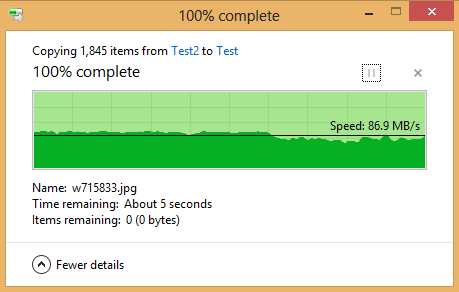
This time the transfer took about 4 minutes and 45 seconds, for a transfer rate of about 88.4 MB/s which is 3.6 times faster than the USB 2 port.
Note: When talking about fragmentation, there are really two components. Actual fragmentation occurs when a single file is broken into multiple parts and those parts are scatter about the disk. The second thing to consider is what I'll call disk scatter. If all the files in a single folder are together on the disk, there is no disk scatter. But if the files are added to the folder over time (as often happens) they tend to be scattered all over the disk. Accessing files scattered like this leads to lots of head movement.
The time to move the read/write head on a disk drive in and out is called the "seek time", once the head is over the right track, the disk must spin until the head is over where you want to read or write a file (this is called rotational latency or delay). Years ago seek times were much, much greater than the rotational delays, now on average they're 2-3 times and can actually be much less for very small head movements. What makes Solid State Drives (SSD) so fast is that the average seek times are 0.08-0.16 ms while the average seek time of desktop drives is about 9 ms and the average of common mobile drives about 12 ms. (A millisecond (ms) is a thousandth (1/1,000) of a second.)
As far as I know, the Microsoft defrag program only works to minimize file fragmentation, it does nothing to minimize disk scatter. For most operations this has almost no impact on performance, usually you're reading or writing individual files, not every file in the folder. However, when you're copying folders from one drive to another, disk scatter becomes an issue. There are defrag programs which also minimize disk scatter, which helps in this case. (However, I saw a case where it really hurt performance as you later added files to the folders. The new files had to be added out at the very end of the disk since that defrag left no empty holes, so the seek times were very high. The Microsoft defrag leaves holes all over the place leading to lower seek times to get to the new files.)
The tests above were reading from an internal drive connected via SATA and writing to an external drive connected via USB. As we saw the times were greatly influenced by the time it took to update the file system on the external drive (which involves a lot of head movement, or seek times). Now let's try reading from the external drive and copying to an internal SATA drive.
First we'll copy Folder 1 from the external drive connect via USB 2 back to an internal drive:
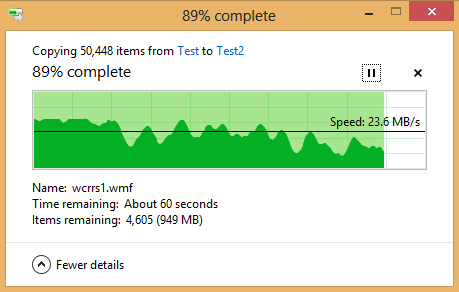
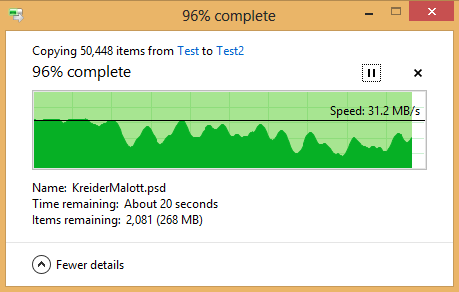
The copy took just over 7 minutes and the average transfer speed was 20.3 MB/s. Not bad.
Next we'll copy the same folder (actually 2,250+ folders) back via a USB 3 connection. Again we see it gets off to a fast start, but then the transfer rate jumps all over the place:
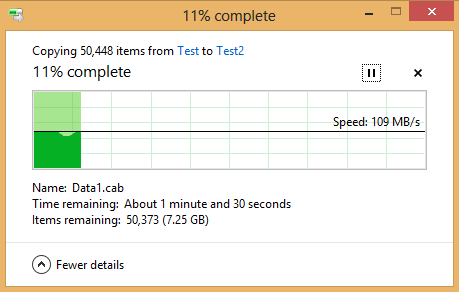
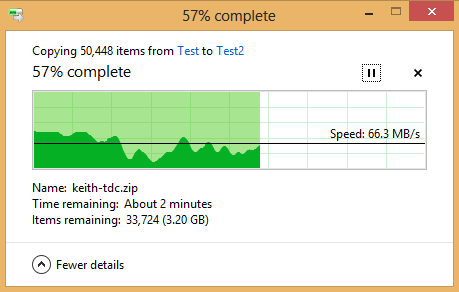
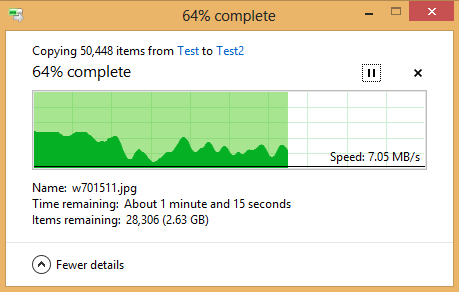
Although the source files on the external drive are have no fragmentation or disk scatter, it still has to create 2,250+ folders and update their contents as each file is added. This involves a lot of head movement (seek time) on the internal drive.
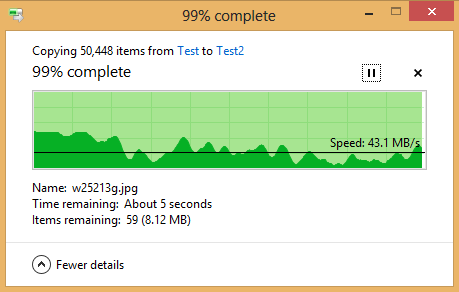
The total time was about 3 minutes and 50 seconds for an average transfer speed of 37.6 MB/s. This is about 1.85 times the speed when connected via USB 2.
Now we'll copy Folder 2 from the external drive connect via USB 2 back to an internal drive:
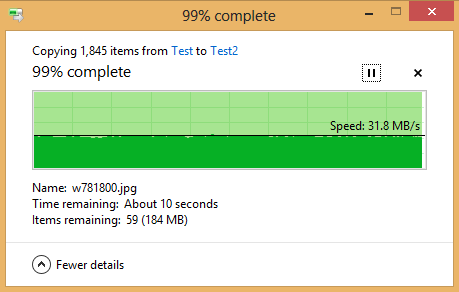
As you can see, because there is no fragmentation or file scatter, the transfer speed is fairly constant. The transfer took just over 13 minutes and the average speed was 32 MB/s. This is very close to the theoretical maximum USB 2 speed, clearly the hardware is taking full advantage of the bandwidth provided by USB 2.
Now we'll copy Folder 2 from the external drive connect via USB 3 back to an internal drive:
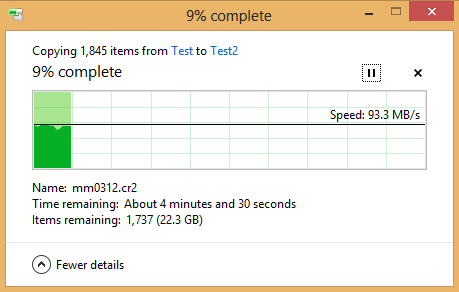
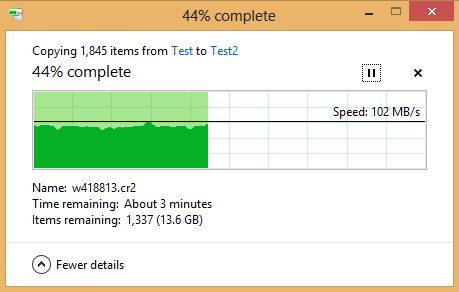
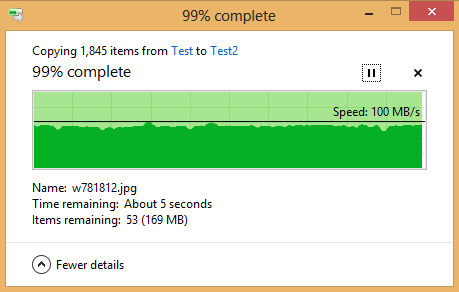
The total time was about 4 minutes and 30 seconds for an average transfer speed of 93.3 MB/s. This is about 2.9 times the speed when connected via USB 2.
It will be a while before hardware can come anywhere close to the theoretical "maximum" transmission speed (625 MB/s) of the USB 3 specification.
Overall I'd say the transfer rate using USB 3 about twice as fast. The transfer rate depends on the file size, the number of folders, and the how fragmented your drives are. In my tests the transfers were 1.5 to 3.5 times faster using a USB 3 port. Small files in lots of folders transferred 1.5-2 times faster. Large files in a single folder transferred 2.5-3.5 times faster.
You're unlikely to see average transfer speeds this high, because they were conducted on drives without fragmentation of file scatter. And because the machine itself is one I just built and is VERY fast, however, for these tests the speed of the machine doesn't make much difference. Nevertheless, you will still probably see a 1.5 to 2.5 times increase in speed on whatever machine you have.
The tests above were done using a new USB 3 powered 2.5" external drive. Recently I decided to see how a USB 3 hard drive "reader" compared with the USB 2 ones I've been using for some time (see Hard Drive "reader"). This reader was the first USB 3 device I ever purchased. It seemed very flaky when used with early USB 3 motherboards ... the transfers seemed to start fast, but then the drive would disconnect and, therefore, the reader was useless, I stopped using it. Decided it was time to try it again. I tried it in the same USB 3 port I used for the tests above and found it was no faster than USB 2. Then I read another review of the same "reader", the ICY DOCK EZ DOCK USB 3.0 HDD adaptor, which shows it being faster when plugged into a USB 3 port.
I finally tried plugging it into a USB 3 port on the back of the machine (instead of the one in the front I had been using) and sure enough, it was twice as fast when transferring LARGE files (4 GB):

I wasn't sure what caused the front ports (there are two connected to the same controller) to revert to USB 2 speed. (The ports on the back are connected to a different controller.) Rebooting didn't help. Realized I had reloaded Windows just after the earlier tests, so thought there might be a missing driver, but there didn't seem to be. I turned to Google and one of the suggestions to others with this problem was to check the BIOS settings. Sure enough, while fixing another problem I'd made many changes which I thought I had restored to their previous settings, but it turned out that on this machine the xHCI mode needs to be set to "Smart Auto" not "Auto".
It's easy not to notice that your USB 3 ports are not as fast as they should be. The lesson for all of us is to have some simple test (like copying a bunch of large files from a USB 3 device) and time it with the device connected via a USB 3 port and then with it connected to a USB 2 port. There should be a big difference in the times, if there's not there's a problem with your USB 3 port.
Yesterday I received a USB 3 card reader that I ordered from Amazon. At first I was really disappointed (because it was plugged into one of the, now slow, front panel USB 3 ports) ... it was no faster than my fast USB 2 reader. However plugging it into one of the USB 3 ports on the back, the performance improved about as expected.
These tests involved downloading 368 images (RAW and JPG) from a Compact Flash (CF) card. The card used was a Lexar Professional 1000X, about as fast as any currently on the market. The reader was the Lexar Professional USB 3.0 dual-slot reader (for CF and SD cards). The RAW images were about 40 MB each, the JPGs about 15 MB. Total size of the 368 images was 9.25 GB (or 9,943,231,215 bytes).
If you frequently download lots of images from camera cards, the difference in time may be enough to encourage you to switch to USB 3. Using USB 2 it takes roughly 5 minutes to download the images. Using USB 3 it takes about 2 minutes.
Using USB 2 the transfer rates were in the 29-32 MB/s range:
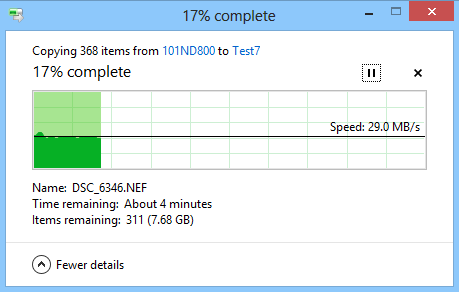
Using USB 3 the transfer rates jumped around more, but were in the 60-100+ MB/s range. Here are some graphs from running the test three different times:
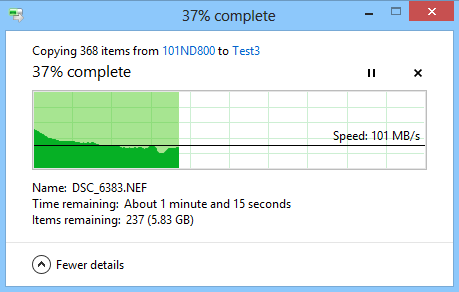
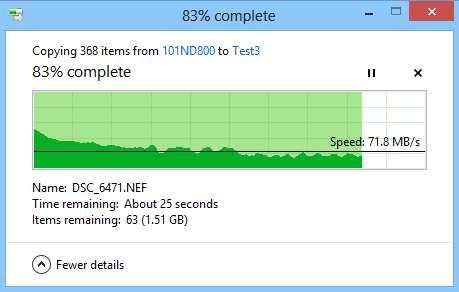
I'm not sure what caused this second test to start out slow, maybe the destination drive had gone to sleep:
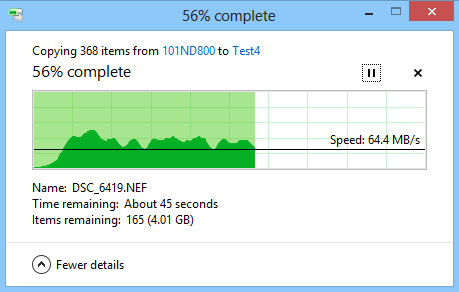
And trying the test again using the front USB 3 port after changing the BIOS:
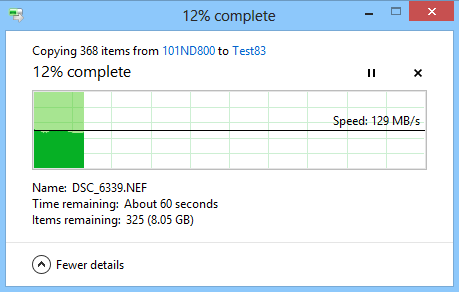
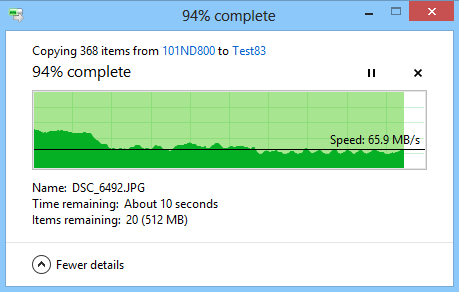
As you see, the transfer rates jumps around a lot, but the total time to transfer 9.25 GB of images was always 2 minutes plus or minus a few seconds. The USB 2 transfer rates were more consistent, and the total time was always about 5 minutes.
I think these graphs showing transfer rates that Windows 8 shows every time I copy files are great! I could immediately tell when my front USB 3 ports were back to speed ... I didn't really need to use a stopwatch to time the transfer. If you have Windows 8 and don't see them, click on "More details" once and it will remember you like to see them and always show them to you.
I'm sure you've all noticed that it takes longer to copy files to a Flash Drive (a.k.a. Thumb Drive, Stick, or USB storage device) than it does to read files from them. Here are some graphs (first writing, then reading) showing the transfer rate to a 8 GB USB 2 device:
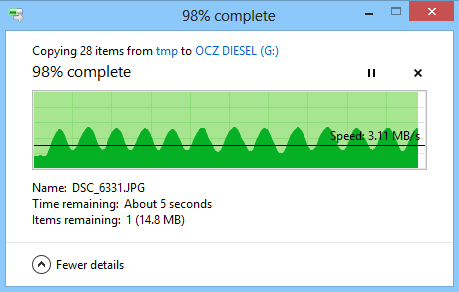
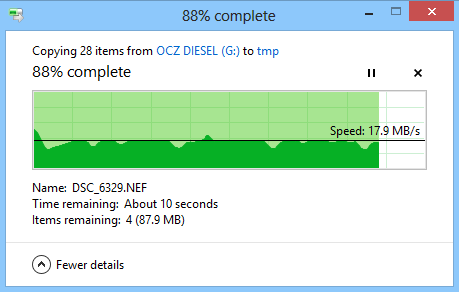
As you can see it takes almost 4-5 times as long to write to the device (3-4 MB/s) as it does to read from the device. As we've seen above, USB 2 transfer speeds can go up to 32-36 MB/s so the limiting factor here is not the speed of the USB port, it's the speed of the device. Speeds of these devices vary all over the place, and unlike camera cards are not well labelled as to speed when you buy them. I thought this one was pretty good, but now that I can actually see the transfer rate I realize it's pretty slow.
After doing the USB 3 tests above, I thought I should give a USB 3 Flash Drive a try. (This was even before I noticed how slow my USB 2 Flash Drives were.) I pick a REALLY inexpensive one, but a large one. It was 32 GBs, but only cost $20 including tax and shipping. I'd never had one bigger than 8 GBs, so thought it might be useful.
First I tried it in a USB 2 port (first writing, then reading):
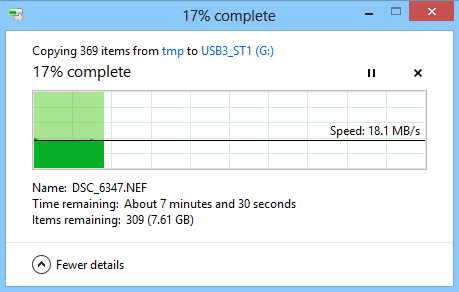
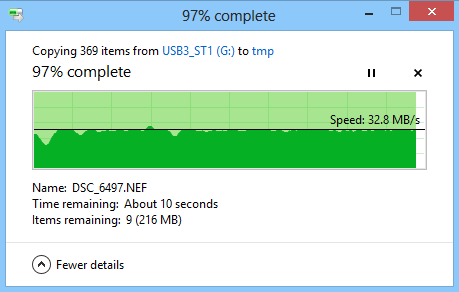
This is more what one should expect from a good quality USB Flash Drive. The read speed (about 33 MB/s) is limited by the speed the USB 2 port, and the write speed (18 MB/s) is about half read speed.
Next I tried the new Flash Drive in a USB 3 port, the write speed was only a little more than 20% faster than observed when using a USB 2 port:
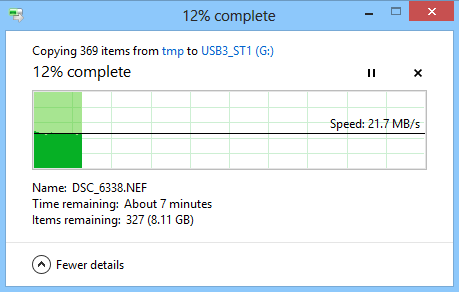
However, the read speeds were about twice the maximum speed one could get using a USB 2 port:
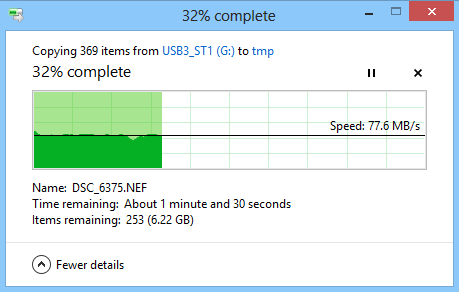
The speed of the chip on the Flash Drive is what's really important, there's no need to replace your USB 2 sticks if they're fast. However, if you're buying new ones, look for USB 3. Think it's more likely the chip will be faster too.
Suggested next choices:
ImagingTips.com Site Map
[an error occurred while processing this directive]